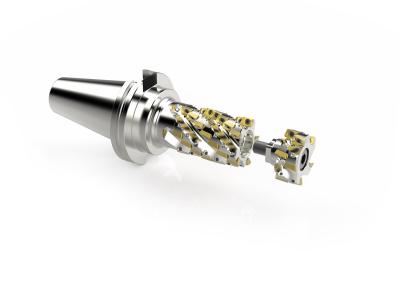
To boost customer productivity, Seco has launched a new semistandard Helical Cutter Program that streamlines the process of obtaining advanced helical cutting tools. The program slashes the typically long lead times required for such custom tooling and will ensure customers in demanding industries such as automotive and aerospace can apply the technology and improve their metal-removal operations as quickly as possible, the company reports.
Custom helical cutters offer numerous advantages for a variety of industries. In aerospace applications involving heat-resistant superalloys and aluminum, the cutters remove more material with deeper cuts compared to standard milling cutters. Such improvements in material removal also benefit manufacturers in the high-volume production environments of the automotive industry, among others.
The new program’s major innovation and effectiveness comes from a newly optimized process. “For many of our customers,” notes Tim Aydt, product manager of Seco’s indexable milling division, “the main barrier to using helical cutters involved the turnaround time between ordering and receiving a custom version of the tool. Our new Custom Helical Cutter Program significantly shortens that time by 50 percent, from 60 days to as few as 30.”
Seco accomplishes this lead-time reduction through a range of semistandardized custom models that virtually eliminates quoting and removes the need for individual tool design and approval processes. Fully replaceable end caps for the tools enable further process optimization and allow manufacturers to replace the front rows of their cutters effortlessly and cost-effectively.
Contact Details
Related Glossary Terms
- gang cutting ( milling)
gang cutting ( milling)
Machining with several cutters mounted on a single arbor, generally for simultaneous cutting.
- helical cutter
helical cutter
Endmill or other cutter with spiral or helical flutes. May be right- or left-hand.
- milling
milling
Machining operation in which metal or other material is removed by applying power to a rotating cutter. In vertical milling, the cutting tool is mounted vertically on the spindle. In horizontal milling, the cutting tool is mounted horizontally, either directly on the spindle or on an arbor. Horizontal milling is further broken down into conventional milling, where the cutter rotates opposite the direction of feed, or “up” into the workpiece; and climb milling, where the cutter rotates in the direction of feed, or “down” into the workpiece. Milling operations include plane or surface milling, endmilling, facemilling, angle milling, form milling and profiling.
- superalloys
superalloys
Tough, difficult-to-machine alloys; includes Hastelloy, Inconel and Monel. Many are nickel-base metals.

